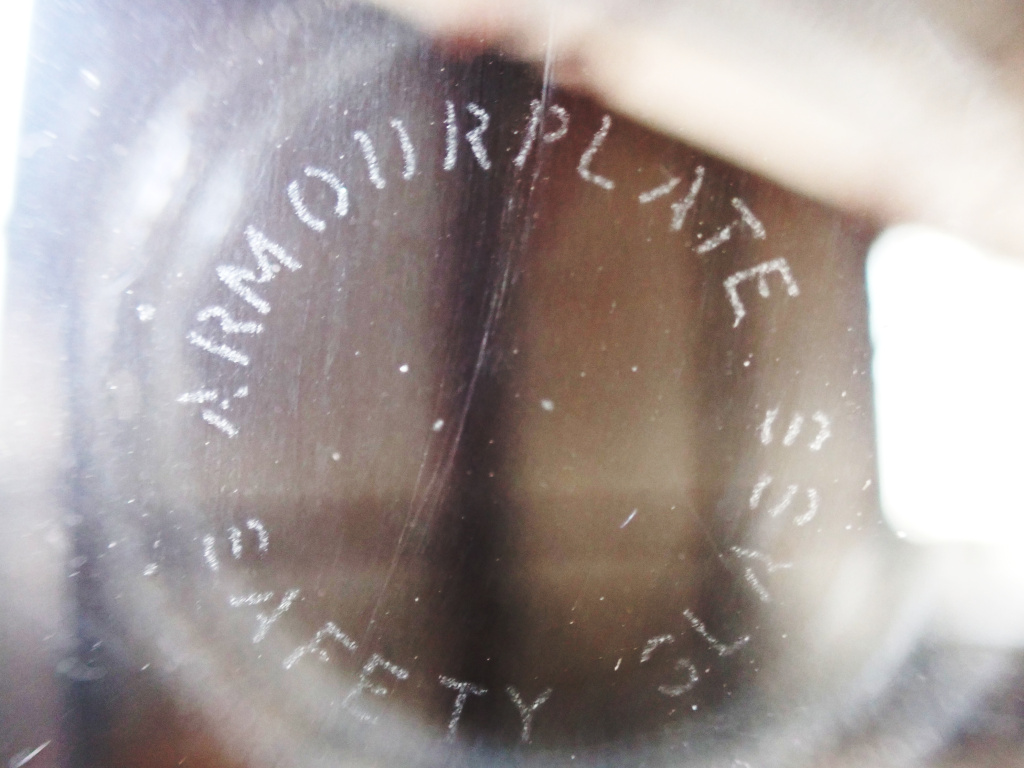The windows.
some interesting details on the car's glass...
Looking in detail at the car's glass also proved interesting. All car glass has etched markings that identify the manufacturer, as well as codes that identify a production period. This can be a very valuable tool when determining the authenticity of a car presented as 'original'. All the cars in the Kelly St Classics collection have always been carefully checked in this way.
Just as with the wheels, the glass proved interesting as it shows the changes that were happening at this time, especially in the Australian assembly plant where BMC was under considerable pressure to increase the percentage of Australian content from about initial 30-40% to an eventual target of 85%. In 1962 it was still only at about 45%, largely because there was a lag of 9-12 months in the UK supply which needed to be used up. With the wheels on this car there is an interesting mix of riveted and welded Rubery Owen wheels (all date-correct, and simply randomly selected from stocks during assembly), and with the glass, a very interesting new development shows up; an Australian-produced door slider window!
The windscreen was obviously not original, being a rural Australian car with 60,000 miles on it. So it was ignored.
Starting from the rear, the back window is branded Indestructo. Ditto with both sliders of the driver's door, and the rear slider of the passenger door. All these had codes indicating production in the final quarter of 1961 (more details below).
The two hinged rear side windows are both from Triplex in the UK. As with the Indestructo glass, these were date coded final quarter of 1961 (more details below).
That leaves the passenger door front slider, and this was interesting. It is made in Australia by Armourplate Safety Glass. Initially I thought it may have been replaced due to damage, but this was at odds with my observations when removing the glass and tracks from the doors, where it was obvious these had never been removed previously. So then it was down to the date code on the glass, and it proved to be first quarter of 1962. I am certain this was fitted during assembly, and it would simply have been grabbed from stock. Cars a bit later in production doubtlessly would have showed increasing percentages of Australian glass as the UK-sourced stcks were used up. An interesting snapshot of history!
Now to the date codes themselves.

↑ Firstly Indestructo. The manufacturers name is in an arch with two
letters under each leg of the name. The first two letters on the left side
are those used for dating, in this case TS. The first letter is used
for the quarter of the year based on BRIT so T = 4th quarter.
The second letter S is for the year based on the word INDESTRUCTO as follows
I=7, N=8, D=9, E=0, S=1, T=2, R=3,U=4, C=5, O=6. TS is 4th quarter of 61.

↑
Now to Triplex. Triplex dates are taken from dots above or below words in the company motif.
The year is shown by a dot under a letters of the words “Toughened”.
A dot under the first letter of either word represents a year ending in a 1
so 61 or 71. Under the second letter is for a year ending 2 so 62 or
72 etc. So in this instance there is a dot clearly under the 'T', so it's
1961. Now for the quarter we move to the word TRIPLEX, and is dated using T, R, E and X of the word TRIPLEX with the
quarters running consecutively T=1st. In this instance the dot is clearly
(not super clear in this photo, but believe me!) over the 'X', so it is 4th
quarter 1961, just like the similarly UK-sourced Indestructo glass.

↑ Finally
the Australian Armourplate. The year dot is above the corresponding letter
in the word ARMOURPLATE. So if it's above the A, it's year 1 in the decade
(1961 in this case), above the R, 1962, and so on. The quarter dot does the
same with the word SAFETYGLASS, with S being 1st quarter, A 2nd quarter and
so on. This glass has a dot over R (1962) and S (1st quarter).
I hope you have found this helpful!